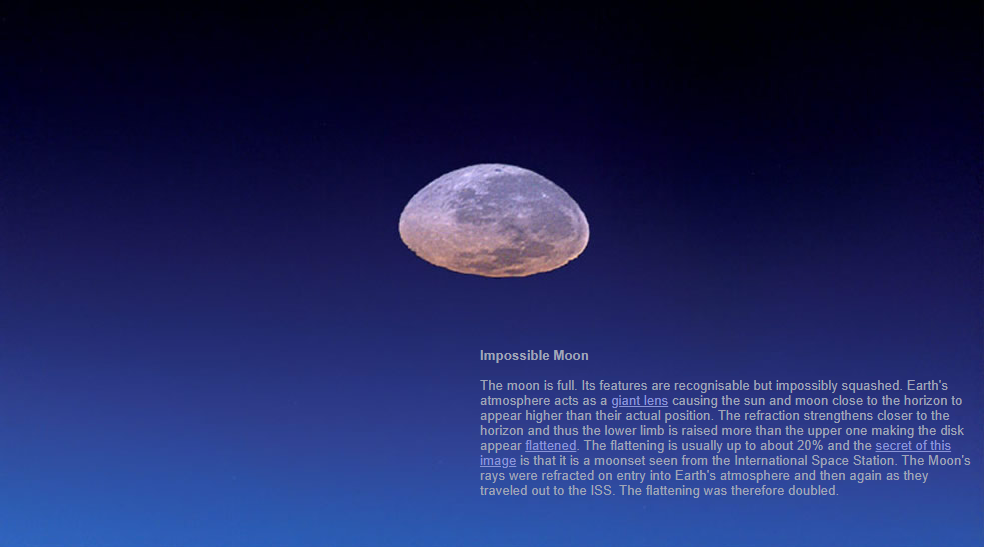Today's Feature Impossible Moon
Today's Feature: The Phenomenon of the Impossible Moon
Have you ever looked up at the night sky and noticed that the moon appears strangely squashed? It's a fascinating optical phenomenon that occurs due to the Earth's atmosphere acting as a giant lens. In this article, we will delve into the details of this intriguing event, commonly known as the "Impossible Moon."
When the moon is full and positioned close to the horizon, its features become recognizable but unusually flattened. This effect is caused by atmospheric refraction, which causes celestial bodies like the sun and moon to appear higher in the sky than their actual positions. As the rays from the moon enter Earth's atmosphere at a low angle, the refraction becomes stronger near the horizon.
As a result of this refraction, the lower limb of the moon is raised more than the upper one, giving the appearance of a squashed disk. Typically, this flattening effect is around 20%. However, in the case of our featured image, which was taken from the International Space Station (ISS) during a moonset, the flattening is doubled.
The secret behind this remarkable image lies in the journey of the moon's rays through Earth's atmosphere. As they enter the atmosphere, they are refracted, bending their path. This refraction occurs again as the rays travel from Earth's surface to the ISS. The combined effect of these two refractions results in a significant distortion of the moon's shape, creating the mesmerizing "Impossible Moon" phenomenon.
To fully grasp the complexity of this phenomenon, it's important to understand how atmospheric refraction works. The Earth's atmosphere is composed of layers with varying densities. When light passes through these layers, it bends due to the change in density. This bending of light is responsible for various optical phenomena we observe in the sky, including mirages and colorful sunsets.
The amount of refraction experienced by the moon's rays depends on several factors, such as the density of the atmosphere and the angle at which the rays enter. When the moon is positioned higher in the sky, the refraction is less pronounced, resulting in a more spherical appearance. However, when the moon is near the horizon, the refraction is at its strongest, leading to the strikingly flattened appearance we see during moonsets.
It's worth noting that the "Impossible Moon" phenomenon is not limited to just the moon. The sun also undergoes similar distortion when it is close to the horizon. In fact, during sunrise and sunset, the sun often appears slightly flattened as well, due to the same atmospheric refraction effect.
In conclusion, the "Impossible Moon" phenomenon is a captivating optical event caused by atmospheric refraction. When the moon is near the horizon, its shape becomes noticeably flattened, creating a surreal sight for observers. The image captured from the ISS during a moonset provides a unique perspective on this phenomenon, as it showcases the doubling effect of refraction on the moon's appearance. So, the next time you gaze at a full moon lingering above the horizon, take a moment to appreciate the wonders of atmospheric optics and the intriguing "Impossible Moon."

Impossible Moon
The moon is full. Its features are recognisable but impossibly squashed. Earth's atmosphere acts as a giant lens causing the sun and moon close to the horizon to appear higher than their actual position. The refraction strengthens closer to the horizon and thus the lower limb is raised more than the upper one making the disk appear flattened. The flattening is usually up to about 20% and the secret of this image is that it is a moonset seen from the International Space Station. The Moon's rays were refracted on entry into Earth's atmosphere and then again as they traveled out to the ISS. The flattening was therefore doubled.
Note: this article has been automatically converted from the old site and may not appear as intended. You can find the original article here.
Reference Atmospheric Optics
If you use any of the definitions, information, or data presented on Atmospheric Optics, please copy the link or reference below to properly credit us as the reference source. Thank you!
-
<a href="https://atoptics.co.uk/blog/todays-feature-impossible-moon/">Today's Feature Impossible Moon</a>
-
"Today's Feature Impossible Moon". Atmospheric Optics. Accessed on November 26, 2024. https://atoptics.co.uk/blog/todays-feature-impossible-moon/.
-
"Today's Feature Impossible Moon". Atmospheric Optics, https://atoptics.co.uk/blog/todays-feature-impossible-moon/. Accessed 26 November, 2024
-
Today's Feature Impossible Moon. Atmospheric Optics. Retrieved from https://atoptics.co.uk/blog/todays-feature-impossible-moon/.